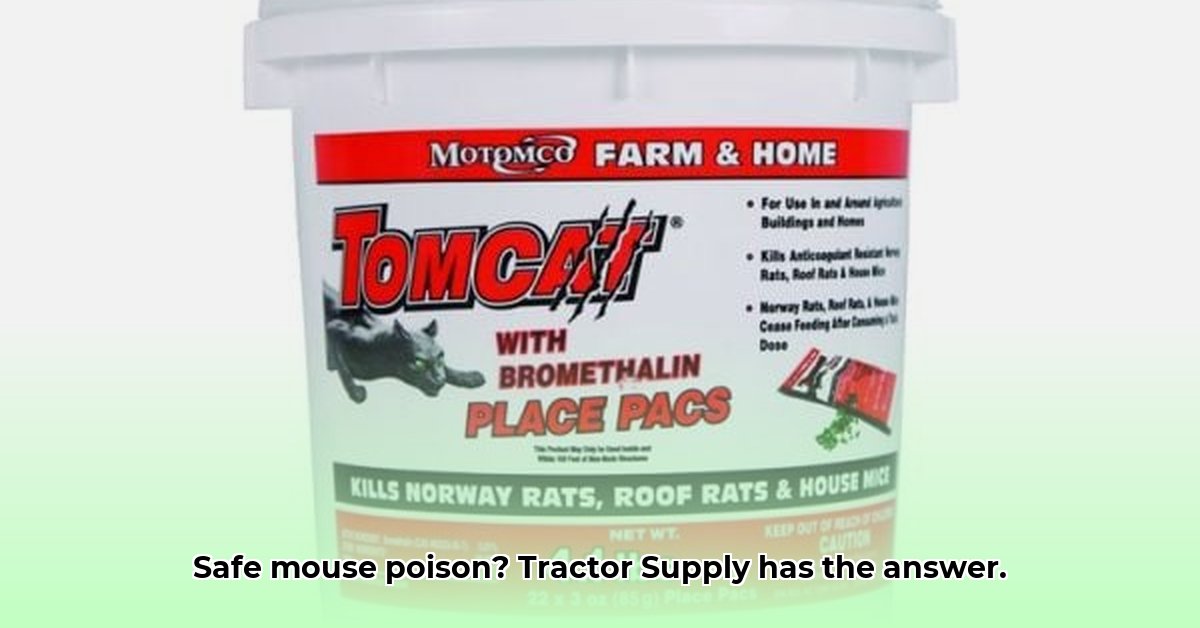
Understanding Rodent Infestations in Sustainable Agriculture
Rodents pose a significant threat to sustainable farming practices, causing crop damage, food contamination, and disease transmission. However, relying solely on chemical rodenticides is unsustainable and harmful to the environment. This guide provides practical, eco-friendly strategies for rodent control. Before implementing any solution, identifying the specific rodent species (e.g., house mice, rats, voles) is crucial, as their behaviors and habitat preferences differ. Assessing the extent of damage—whether it's gnawed crops, damaged stored grain, or structural damage—helps determine the appropriate control measures. For information on pet health, check out this helpful resource on dog deworming.
Sustainable Rodent Control Methods: A Multi-pronged Approach
Effective rodent management in sustainable agriculture requires an integrated pest management (IPM) approach, combining several strategies for optimal results. This holistic perspective minimizes reliance on harmful chemicals and protects the environment.
1. Habitat Modification: Removing the Appeal
Rodents require food, water, and shelter. By modifying their habitat, you make your farm less attractive. This is often the most effective first step in rodent control.
- Eliminate food sources: Store grains and feed in sealed containers. Clean up spilled feed or grain immediately. Remove weeds and other vegetation near buildings that could provide shelter.
- Reduce water access: Repair leaky pipes and faucets. Empty standing water sources.
- Restrict shelter: Seal cracks and holes in buildings and fences. Keep vegetation trimmed back from buildings.
2. Trapping: A Humane Approach
Trapping is a humane and effective method for reducing rodent populations.
- Trap placement: Strategically place traps along walls, near rodent burrows, or in areas of high activity.
- Trap types: Choose appropriate trap types based on the size of the rodent. Snap traps are effective for small rodents, while larger traps might be necessary for rats.
- Regular monitoring: Check traps daily and dispose of captured rodents responsibly, following local regulations. Never leave captured rodents in traps for extended periods.
3. Biological Control: Nature's Helpers
Introducing natural predators can significantly reduce rodent populations. This method requires careful research and planning to avoid unintended ecological consequences.
- Predator attraction: Create habitats that attract natural predators like owls, snakes (where applicable, and with consideration of local regulations and potential risks), and certain birds of prey. This may involve installing owl boxes or leaving strategically placed brush piles.
- Habitat considerations: Understand the habitat needs of your chosen predators to ensure their success. This may include providing nesting sites, shelter, and prey species.
4. Responsible Rodenticide Use (When Necessary): A Last Resort
Use rodenticides only as a last resort when other methods prove insufficient.
- Product selection: Choose products with the lowest possible toxicity to non-target species. Always carefully read and follow label instructions. Products available at Tractor Supply and similar retailers vary in their toxicity levels and effectiveness.
- Bait station placement: Use bait stations to minimize exposure to non-target animals, pets, and children. Place them strategically where only rodents can access them.
- Safety precautions: Wear appropriate personal protective equipment (PPE) when handling rodenticides. Dispose of used bait and packaging properly, in accordance with the product's instructions.
5. Crop Rotation: Disrupting Patterns
Rotating crops can disrupt established rodent habitats and food sources. This is a long-term strategy most effective when combined with other methods.
- Planning: Carefully plan your rotation to avoid planting consecutive crops that are attractive to rodents. This may require understanding which crops are particularly vulnerable to rodent damage in your area.
Choosing the Right Method: A Personalized Approach
Selecting the most appropriate rodent control method depends on several factors:
| Factor | Considerations |
|---|---|
| Farm Size | Larger farms may require a combined approach; smaller farms may find trapping sufficient. |
| Crop Type | Certain crops are more susceptible to rodent damage than others. |
| Budget | Trapping is generally less expensive than rodenticides; larger budgets allow for more comprehensive strategies. |
| Pest Severity | Minor infestations might only require habitat modification; severe infestations may necessitate a multi-pronged approach. |
| Local Regulations | Always comply with local regulations on pesticide use and rodent control. |
Monitoring and Evaluation: Continuous Improvement
Regularly monitor the effectiveness of your chosen method(s). Are rodent numbers decreasing? Is crop damage lessening? Adjust your approach based on observations. A combination of methods is often more effective than a single strategy.
Legal and Regulatory Compliance: Staying Informed
Always comply with local, state, and federal regulations concerning pesticide use, rodent control, and the proper disposal of rodenticides and dead rodents.
Resources: Expanding Your Knowledge
Your local agricultural extension service and university resources are valuable sources of information and support. They provide tailored guidance, updated information, and educational opportunities.